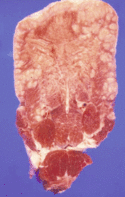Actinobacillosis - Cattle
Revision as of 13:09, 26 May 2010 by Bara (talk | contribs) (Created page with '*"Wooden tongue" *In cattle - very widespread in world, but rather sporadic, less common now than it was. ====Clinical==== …')
- "Wooden tongue"
- In cattle - very widespread in world, but rather sporadic, less common now than it was.
Clinical
- Seen in youngish animals in beef breed, especially sucklers on poor forage.
- Starts like foot and mouth disease - dull, salivating (if only one animal is unlikely to foot and mouth). - nearly always sporadic.
- ongue feels like a big lump of wood especially dorsal part of posterior 2/3rds.
- Small areas of ulceration are often found on side of tongue.
Pathogenesis
- Very similar to Mandibular Osteomyelitis ("lumpy jaw").
- Causal agent: Actinobacillus lignieresii (small gram -ve) gets into tongue via small abrasions.
- Pathogen is very widespread in environment.
- Progressive disease - low virulence but high persistence so animal may stop eating and eventually die but can be treated.
Pathology
- If cut into tongue, substance of tongue changed to fibrous stroma with raised red nodules. (2-3mm across).
- This lesion is a pyogenic granuloma with central sulphur body.
- Can spread from tongue to other tissues e.g. retropharyngeal lymph nodes and palate.
- This type of lesion is caused by the host response to the pathogen, rather than directly a pathogen effect.
Other sites
- Occasionally can see generalised infections but more commonly spreads to local lymph nodes of alimentary tract.
- Organism can be inhaled causing actinobacillus pneumonia.
- Can affect rumen wall.
- In skin forms a neoplastic like mass in dermis.

